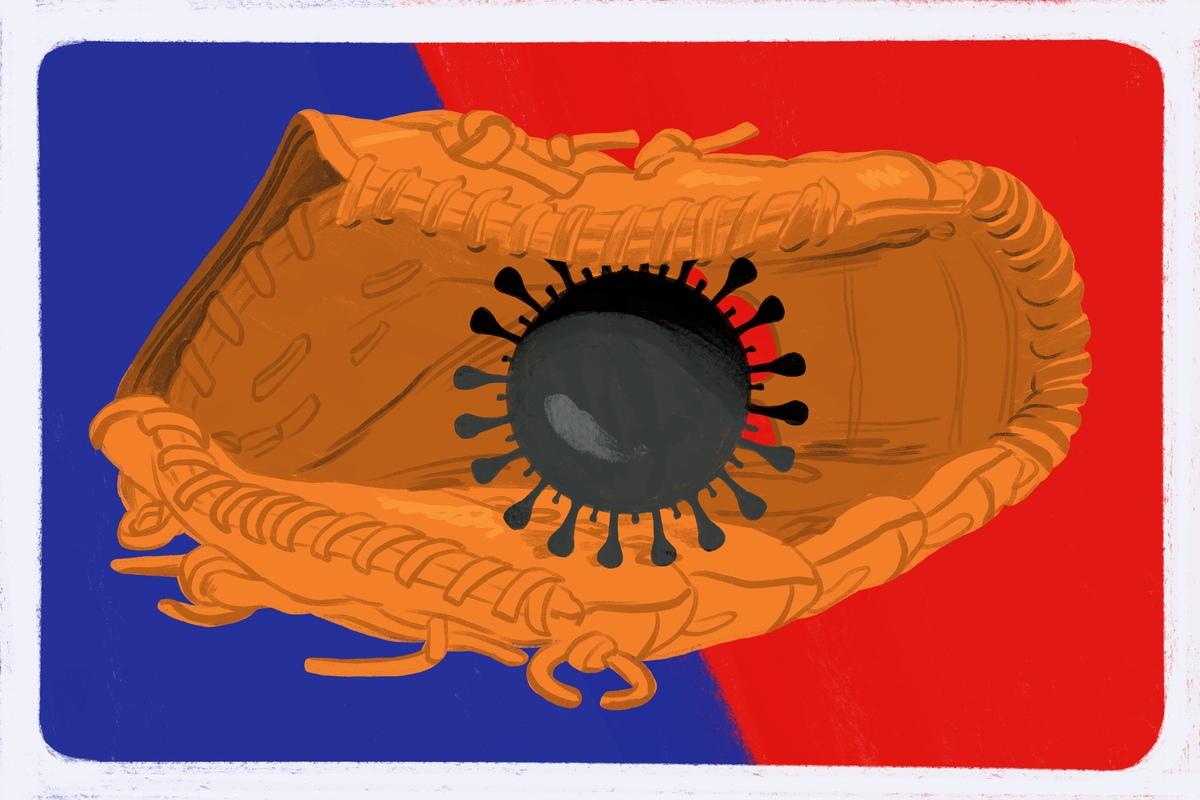
The news came around 8:30 p.m. ET on Tuesday night: MLB and the players union had finalized the last bits of their return-to-play agreement, and baseball was back. Hurray!
More ominous news came less than an hour later: All-Star outfielder Charlie Blackmon and two Rockies teammates had tested positive for COVID-19 after working out at the team facility, and Coors Field would need to be closed for the week. The ostensible moment of relief and celebration was almost immediately tempered by a complication courtesy of the coronavirus—whoever’s writing this story has a heavy hand for symbolism.
The league managed to address its economic conundrum for the 2020 season, but the broader problem—which delayed the season in the first place, and thus precipitated the financial concerns—remains. Baseball may be back, but the pandemic never left. And as the season approaches within a month, it’s difficult not to feel, above all other emotions, overwhelming anxiety and concern about the risks MLB is taking by staging a season at all.
The players and league office have agreed on health and safety procedures, to be fair—more than 100 pages of them, with precautions ranging from a ban on spitting to mandatory masks for staff members in the dugout. Players will be encouraged to shower away from the ballpark. Long rain delays will be eliminated to slash unnecessary downtime with players in close proximity.
But amid a growing coronavirus caseload across the country—Wednesday saw a record high for positive tests, due to a combination of increased testing and increased spread of the virus—these granular efforts may well miss the forest for the trees: The virus is still spreading, at an accelerated pace in some places, and no amount of saved spit or wet rags on the mound can keep it outside a baseball stadium.
Most notably, once the shortened season begins, the league’s safety plans apply only to behavior at the ballpark; outside, players and staffers are on their own, only an honor code keeping them from braving crowded bars without a mask. (Ask the NWSL’s Orlando Pride how that notion works in practice.) Yet even responsible social distancing is not guaranteed to keep everyone involved in an MLB organization safe—without the “bubble” environment of other sports, they will all presumably be in regular contact with family members, fellow customers at grocery stores, and a whole web of potential vectors as the virus hops from patient to patient.
And if one player contracts the virus, it’s likely that his teammates won’t be far behind. “There will be positive cases and there will be transmission between players,” researcher Laura Albert told The Ringer’s Michael Baumann last month. “And I anticipate it happening on airplanes and buses, in the locker rooms or bathrooms. It’s not totally clear how we can change those spaces to be safe if there’s a bunch of people using them.”
To wit: The season hasn’t even begun, and at least 40 MLB players and staff members have already tested positive in the last week; that count includes a dozen members of the Phillies organization alone. MLB has already been forced to close all its spring training complexes for deep cleans.
In the event of a spreading sickness, moreover, even though young, athletic baseball players are more likely as a group to withstand positive cases without complications than older patients with underlying health conditions, danger still populates MLB clubhouses. Some players are at higher risk due to their health histories: Carlos Carrasco told ESPN he’s been advised to “stay home” because of his leukemia, but is preparing to play anyway; other players have had chemotherapy, or a spleen or colon removed, or Type 1 diabetes. Players also might have high-risk family members to whom they could spread the virus, and those who opt out of playing for fear of putting loved ones at risk may not receive salary or service time for the season. (MLB’s agreement states that high-risk players who opt out would definitely receive both, while the teams of players with high-risk family members could make that decision on a case-by-case basis.)
And with so many players involved in the sport, as compared to the likes of the NBA, the numbers are large enough that it’s quixotic to expect nothing to go wrong. The league’s effective player pool this season counts 1,800 men—60 per team, split between the major-league roster and a taxi squad to serve as alternates in the case of injury or infection. That’s a whole lot of opportunity for disaster; even if each player is hypothetically 99 percent safe from severe harm thanks to prevention measures and his youth, 18 players on average would still be in danger of extreme sickness, or worse.
Those discomfiting concerns are all centered on the short term, too, without taking into account any lingering damage that might prove especially harmful to a professional athlete. A recent piece from Vox summarized potential areas of long-term damage in recovered COVID-19 patients, such as lung scarring, heart damage, and neurological issues.
Yet even if those many hundreds of players and their many hundreds of family members all avoid the worst of the virus’s effects this season, and even if they all suffer no long-term damage from the nearly inevitable exposure to the virus, they’re not the only people involved in the production of a baseball season. And some of those other folks are in much more precarious health brackets than 20-something athletes.
To focus on just one such group—here are some thoughts about many more—seven MLB managers are in their 60s or 70s, led by new Astros skipper Dusty Baker, a 71-year-old Black man who will be managing amid a pandemic that discriminates by age and race. Seven more managers are between the ages of 55 and 59 (or will turn 55 during this season).
Baker happens to be the manager of a team that plays in Texas, which won’t merely host games; the state appears poised to host games with fans. Texas governor Greg Abbott reiterated Tuesday that his stance on allowing fans in ballparks hasn’t changed—on the same day that he announced records in the state’s number of COVID-19 infections and hospitalization rate.
On Wednesday, Astros owner Jim Crane, who hired Baker this spring, followed Abbott’s lead. He said his goal was to “get some people in the building and sell some tickets, some merchandise, some cold beer, whatever they’d like to have.” The state’s current plan would allow parks to operate at 50 percent capacity—as if the pandemic weren’t already a sufficient logistical challenge without 20,000 fans crowding the concourse.
Texas’s optimism about fan attendance may be unique because of the local government’s laxity—or it may not be; the Red Sox and White Sox apparently want fans, too—but it’s not the only baseball-playing state suffering from a rapid spread at the moment. Fifteen MLB teams—half the league—play in states with a current estimated transmission rate higher than 1, meaning the virus is spreading quickly in those areas, even accounting for increased testing.
And because MLB is not adopting a bubble structure—which admittedly would have been subject to scrutiny itself—the other 15 teams won’t be able to avoid the hot spots. The Red Sox may be relatively safe in Massachusetts, which may have the lowest transmission rate in the country, but they also must travel to Florida to play the Marlins and Rays. Toronto would conceivably be on their itinerary as well, but international travel is even more complicated, and MLB reportedly didn’t submit the required health plan to Canadian health authorities until Wednesday.
Earlier this month, the New York Daily News’s Bradford William Davis reported that despite MLB’s assurances that it was working on coordinating health protocols with local governments, only five county and city health departments “confirmed any interaction with MLB or the local team in their jurisdiction regarding health and safety measures.”
Davis continued: “Other local health leaders presented serious questions—if not irreconcilable conflicts—with the proposed procedures in place, or at least what they understood of them. And that’s when health departments spoke at all.”
With the league’s agreement reached and the season timeline set, with Spring Training 2.0, Summer Edition set to begin less than a week from now on July 1, those conversations will surely pick up now. But with all the complications and all the uncertainty, with the twin challenges of a surging national health crisis and only partial safety procedures, it’s not difficult to imagine a scenario in which an outbreak inside the league forces more questions about the sustainability of a season played in such circumstances.
The 2020 season is coming. Or at least it’s supposed to; the month between now and Opening Day is a long time for the shape of the coronavirus in the United States to morph once again. Those are the facts.
The question is: Should the season come? Or, more perniciously: How long until MLB must reckon with whether to shut the whole operation down once again?

